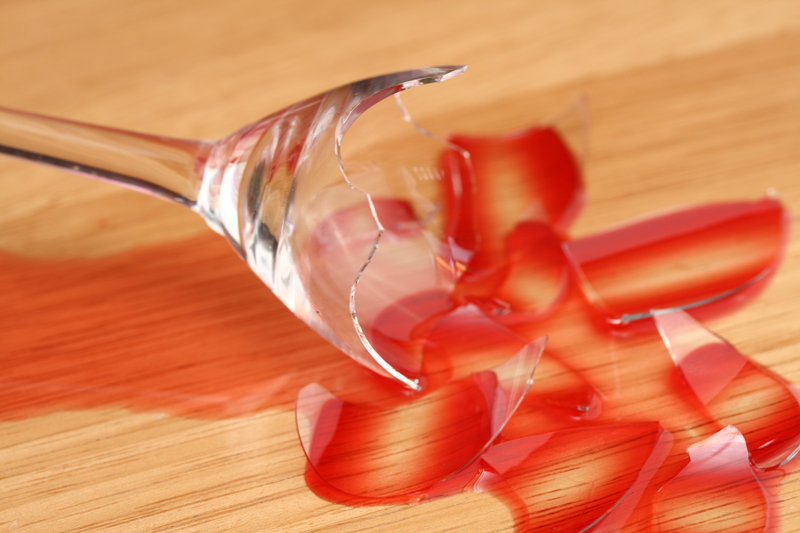Tenants' Basic Guide to End of Tenancy Cleaning
Posted on 07/06/2025
Tenants' Basic Guide to End of Tenancy Cleaning
Moving out of a rented property can feel overwhelming, especially when it comes to making sure the place is spotless for the next occupants. End of tenancy cleaning is a crucial requirement for tenants to secure their deposit and leave the property in pristine condition. This comprehensive guide provides tenants with all the necessary information, tips, and step-by-step instructions to meet their end-of-lease cleaning obligations. If you want to increase your chances of a full deposit return and foster a good relationship with your landlord, keep reading this tenant's guide to end of tenancy cleaning.

What is End of Tenancy Cleaning?
End of tenancy cleaning refers to the deep cleaning of a rented home or apartment before moving out. Tenancy agreements commonly require tenants to leave the property in the same clean state as when you moved in, accounting for fair wear and tear. Meticulous cleaning ensures smooth handover, avoids disputes, and helps recover your full deposit.
Why is End of Tenancy Cleaning Important for Tenants?
- Deposit Recovery: Neglected cleaning is the leading reason landlords and letting agents deduct from deposits.
- Avoid Disputes: Proper cleaning prevents disagreements when the landlord inspects the property.
- Rental References: Leaving the property clean increases your chances of receiving positive references for future tenancies.
- Legal Obligations: Tenancy agreements obligate tenants to return premises in a similar condition as received.
- Goodwill: A pleasant, clean property benefits incoming tenants and maintains a good reputation with landlords.
When Should Tenancy Cleaning Be Done?
End of lease cleaning is best performed after your belongings are packed and moved out. This allows you to access all areas and ensure no corner is overlooked. Plan to complete the cleaning a day or two before handing back the keys and before the final inventory inspection by your landlord or agent.
Step-by-Step Guide to End of Tenancy Cleaning
1. Review Your Tenancy Agreement
Before starting, review your tenancy agreement to understand specific cleaning requirements. Some landlords expect carpets to be professionally cleaned or for appliances to be cleaned thoroughly. Knowing the expectations avoids last-minute surprises.
2. Gather the Necessary Supplies
- All-purpose cleaner
- Anti-bacterial cleaner or disinfectant
- Glass cleaner
- Oven and hob cleaner
- Descaler for taps and kettles
- Floor cleaner/appropriate products for hardwood, tiles, or carpet
- Microfiber cloths, sponges, and scrubbers
- Vacuum cleaner and mop
- Bin liners and gloves
- Toilet and bathroom cleaning products
3. Declutter and Empty the Property
Remove all your belongings, personal items, and rubbish from the property. Don't forget attic spaces, cupboards, and under the stairs. Ensure nothing is left behind except furnishings or appliances belonging to the landlord.
4. Start with the Kitchen
The kitchen is where landlords often find cleaning faults. Pay special attention to the following areas:
- Oven and hob: Remove all traces of grease and burnt food. Use a specialist oven cleaner and follow manufacturer's instructions.
- Fridge and freezer: Defrost, wipe all surfaces, deodorize, and leave the door slightly open to prevent odors.
- Surface tops, cupboards, and drawers: Empty, vacuum crumbs, and wipe inside and out.
- Sinks and taps: Remove scale, stains, and shine metal surfaces.
- Microwave, kettle, and small appliances: Clean thoroughly, both inside and outside.
- Floor: Sweep, mop, and degrease tile grout if needed.
5. Thoroughly Clean Bathrooms
- Toilet, sink, bath, and shower: Disinfect all surfaces, descale taps, tiles, and showerheads.
- Mirrors and glass: Remove smudges and water marks.
- Floor: Scrub tiles, including grout, and mop the floor.
- Extractor fans and light fittings: Dust and ensure they are working and clean.
- Bathroom cabinets: Empty and wipe thoroughly.
6. Clean Bedrooms and Living Areas
Bedrooms and living rooms require careful attention, especially if carpets or furnishings are provided.
- Carpets and rugs: Vacuum thoroughly. If stained, consider rental carpet cleaners or professional carpet cleaning.
- Wardrobes, drawers, and cupboards: Wipe inside and out, removing all debris.
- Walls: Gently remove marks or scuffing. For stubborn stains, use a mild sponge and cleaning product suitable for painted surfaces.
- Windows: Clean inside panes, sills, and frames. Some agreements also require exterior window washing.
- Blinds and curtains: Dust blinds, and if possible, launder or dry-clean curtains.
- Light switches and sockets: Wipe down to remove fingerprints and dust.
7. Don't Forget Hallways, Entryways, and Stairs
High-traffic areas collect the most dirt. Pay extra attention to these spaces:
- Clean skirting boards, bannisters, and railings
- Vacuum and mop floors
- Wipe down doors, handles, and frames
8. Tackle Outdoor Areas (If Applicable)
If your rental includes a garden, patio, or balcony:
- Remove litter and debris
- Mow lawn, trim hedges, and sweep pathways
- Clean outdoor furniture
- Sweep and remove leaves or moss
End of Tenancy Cleaning Checklist
For thorough end of tenancy cleaning, use this essential checklist:
- All rooms vacuumed and dusted
- All internal windows cleaned
- Floors mopped or steam-cleaned
- Kitchens and bathrooms disinfected
- Appliances degreased and wiped down
- Walls inspected for stains or marks removed or painted
- Skirting boards and surfaces wiped
- Furniture, if supplied, cleaned or polished
- Bins emptied and sanitized
- Outdoor areas tidy and free of rubbish
Professional End of Tenancy Cleaning vs. DIY
Should You Consider Hiring a Professional?
While many tenants perform DIY end of tenancy cleaning, professional cleaners offer expertise and specialized tools. Professional cleaning services often provide a cleaning certificate, which gives landlords peace of mind. Consider professional cleaning if:
- Your tenancy agreement specifically requires it
- The property is very large or heavily soiled
- You lack the time, equipment, or ability to clean to the expected standard
Always ask for a detailed receipt and guarantee if you hire a company, as some landlords require proof of professional cleaning.
DIY End of Tenancy Cleaning Tips
- Work from top to bottom so falling dust or debris lands on surfaces not yet cleaned
- Use suitable cleaning products for each surface to avoid damage
- Enlist help from friends or housemates to make the process faster
- Take "before" and "after" photos for your records
- Read manufacturer guidelines for appliances and surfaces
Most Overlooked Areas in End of Tenancy Cleaning
To secure your deposit, pay attention to these commonly missed cleaning spots:
- Behind and beneath appliances
- Inside cupboards and drawers
- Extractor fans and filters (in kitchen and bathrooms)
- Light fittings and lampshades
- Doors, frames, and door handles
- Windowsills and tracks
- Radiators and behind radiators
- Shower screens and grout
End of Tenancy Cleaning: FAQs for Tenants
Can My Landlord Deduct My Deposit for Poor Cleaning?
Yes, if cleaning isn't up to standard, landlords can make deductions to cover professional cleaning services. Protect yourself by following a strict end of lease cleaning checklist and documenting the cleaned property.
Do I Need Receipts for Professional Cleaning?
Always keep receipts if you use professional cleaners, especially if your agreement specifies this requirement or if your landlord asks for evidence.
What If My Landlord Isn't Happy With the Cleaning?
Try to resolve issues amicably. Suggest a joint inspection, present your cleaning receipts, and "before and after" photos. If necessary, refer to your tenancy deposit scheme if you dispute deductions.
How Clean is Clean Enough?
The property must be in the same state of cleanliness as at the start of your tenancy, excluding fair wear and tear. Consult your inventory or check-in report to compare condition.
Are Carpets and Upholstery Included in End of Tenancy Cleaning?
Carpets, rugs, and upholstered furniture should be vacuumed and, if stained, shampooed or steam cleaned. Some landlords require professional carpet cleaning; consult your tenancy agreement for details.

Tips for a Stress-Free End of Tenancy Cleaning
- Start early: deep cleaning always takes longer than planned.
- Check the inventory report: Use the original inventory as your benchmark.
- Photograph everything: Document the property's condition before and after cleaning.
- Use labeled cleaning products: Suitable for surfaces to avoid damage.
- Don't skip professional cleaning if required by the agreement.
- Double-check hidden corners, skirting, and behind furniture.
- Empty bins, remove all rubbish, and ventilate the property before handover.
- Organize a final walkthrough with the landlord if possible.
Conclusion: Mastering Your End of Tenancy Clean
End of tenancy cleaning is an essential part of moving out of a rented property. Attention to detail, organization, and a thorough approach ensure you meet your obligations, avoid unnecessary deductions, and leave the property in excellent condition.
Whether you choose a professional tenancy cleaning service or do it yourself, following this step-by-step guide and checklist will set you up for a smooth and successful transition. Remember, a clean property is your best guarantee for a hassle-free deposit return and a positive rental reference.
Prepare, clean thoroughly, and leave your rented home with confidence!




